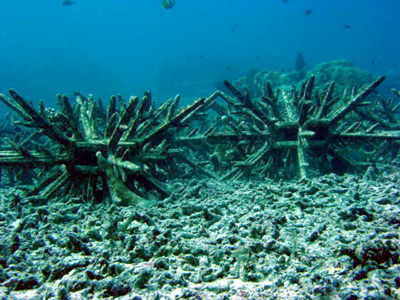May 8, 2006
Artificial Reefs: Great for the Ecology and the Economy
By Michael D. Shaw
Every so often an idea emerges that establishes support across a broad spectrum of environmentalists, scientists, elected officials, and ordinary citizens. The one we’re talking about today is the creation of artificial reefs. These are man-made structures, which can include everything from sunken cars or ships, concrete blocks, sandbags, and yes, offshore oil platforms, that attract marine life. More than this, a growing body of ongoing marine research indicates that these structures actually increase the amount of sea life rather than simply attracting existing fish.
Ironically, what would seem at first blush to be horrible bit of pollution on the seabed, artificial reefs actually serve to enhance the environment.
The original artificial reefs, of course, were sunken ships, and as the technology of undersea exploration developed, it was quickly noted that they became havens for marine life—in Davy Jones’ locker. While most of these shipwrecks were not intentionally caused (at least by the mariners aboard them), it was only in the mid-1950’s that the notion of purposely sinking damaged or outdated ships—to establish them as artificial reefs—has come to the fore.
On January, 2002, the Ecuadorian-registered cargo ship Jessica ran aground near the Galápagos Islands, spilling over 180,000 of diesel and bunker fuel oil. Fortunately, with the help of U.S. Coast Guard vessels that were able to contain and recover most of the oil, little damage was done. However, heavy seas made removal of the ship virtually impossible, so it was decided to make the wreck into an artificial reef.
Thus, an environmental victory was won in a region famed as an ecological treasure.
The year before, the Golden Venture, an old freighter used to smuggle refugees from China to the United States, until it ran aground in 1993, was sunk off the coast of Boca Raton, Florida, to create an artificial reef. Hundreds more examples could be cited.
As to oil rigs, generally regarded as enviro-wicked, it turns out that removal of them can be problematic. Beyond the logistical problems involved with tearing them down, transporting them back to dry land, and then disposing of them, several government studies indicate that the removal of these platforms has resulted in the loss of valuable reef and fishery habitat. Indeed, researchers report fish densities to be 20 to 50 times higher at oil and gas platforms than in nearby open water.
So, what’s the proper enviro-friendly solution? Turn them into artificial reefs. In a shining example of Big Oil cooperating with the ecosystem, in the Rigs to Reefs program, the underwater portion of obsolete platforms used in the Gulf of Mexico are preserved as fish habitat. More than 200 platforms have been converted, to say nothing of the millions of dollars saved, that has been donated to the states. Rigs to Reefs is widely viewed as successful, with continuing support from the oil and fishing industries, environmental groups and the public.
Consider also subway cars, already symbolic of saving energy. Since the beginning of 2001, the New York Transit Authority’s artificial reef program has deployed decommissioned “Redbird” subway cars at reefs in Delaware, South Carolina, Virginia, Georgia, and New Jersey. Before the cars were deployed, they were stripped of any enviro-offensive materials, with wheel assemblies and undercarriages recycled as scrap metal. Research indicates that the cars may be colonized by up to 200 species of fish and invertebrates.
Another area of artificial reef construction involves the so-called reef ball, a line of specially designed and patented marine-friendly concrete structures, that are primarily installed to restore ailing coral reefs and to create new fishing and scuba diving sites. More than 500,000 reef balls are currently in place, as an integral part of thousands of artificial reef projects worldwide. Reef ball implementation is coordinated through the Georgia-based Reef Ball Foundation, formed to help preserve and restore coral reefs and our ocean ecosystems, along with promoting and commercializing the technology.
Finally, we should mention Memorial Reefs. These artificial reefs combine reef balls with ashes of the dear departed, while helping out the marine ecosystem. Reef plots are available for the whole family and their favorite pets! Just another example of how true environmentalism is also good for business.

